Trusted by:
Updated: June 25, 2025
11 min read
Virtual Learning: How to Reward Learners in Virtual Courses?
What if you could transform your virtual learning courses into interactive, rewarding experiences that captivate your students? In this article, we'll share practical tips that can make a real difference. Keep reading to find out how to boost engagement and make your online teaching more effective.
Struggling to keep your students focused and motivated in your virtual classroom? You’re not alone. It's proven challenging to keep many virtual students engaged and excited about learning.
Many teachers do their best to keep learners engaged in an online environment where distractions are constant. And many of them fail.
One effective way to address this is by recognizing and rewarding their efforts with certificates or badges, which can make a real difference in improving their interest and participation.
Today, we'll show you some ideas for how to make your online education scheme effective for your students – and yourself.
What is virtual learning?
Virtual learning means taking classes online, where students can access lessons and materials through the internet.
It became especially popular during the COVID-19 pandemic when schools had to close, and students started learning from home. Since then, it’s grown into a popular way to reach students everywhere. Many teachers now use virtual learning to offer flexible schedules and personalized instruction.
As it continues to evolve, enrolling and keeping students engaged has become a top priority.
🧐 Did you know? Certifier is an online platform that empowers educators to create and distribute digital certificates effortlessly. With Certifier, you can design customized certificates that honor your students' achievements. Boost motivation and engagement in your virtual classroom!
Types of online courses you can organize
Online courses offer different formats to cater to various learning styles and needs. Some courses are more structured, while others give learners more flexibility to complete the work at their own pace.
The three main types of virtual learning are synchronous, asynchronous, and hybrid.
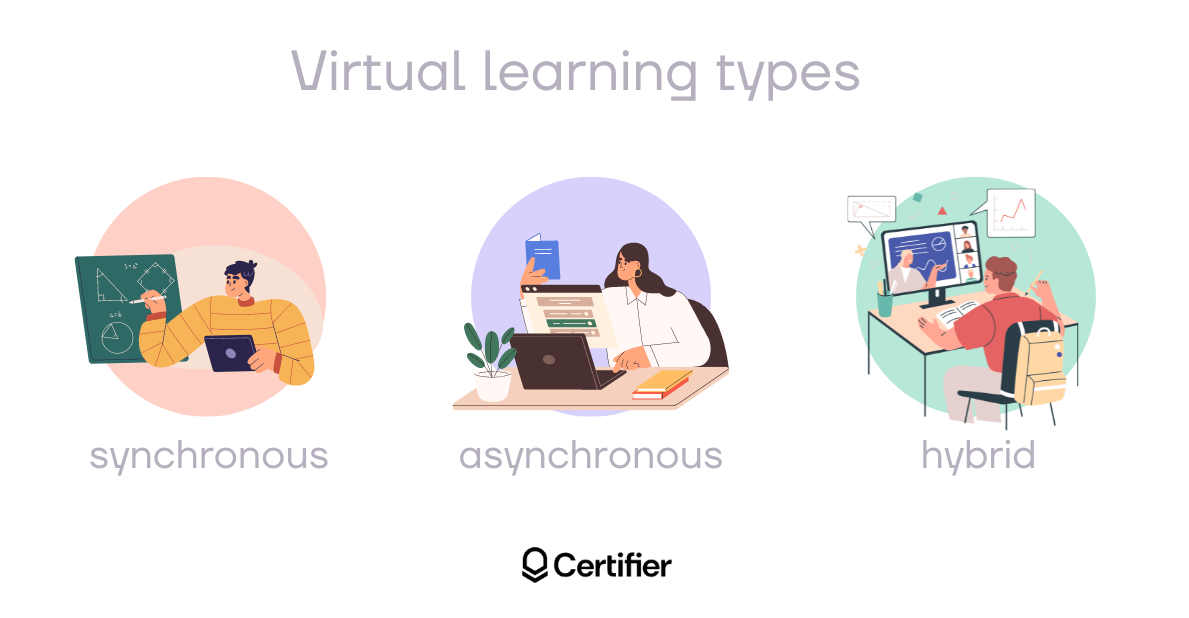
It's important to note that some of these formats can be interconnected depending on the course requirements.
Synchronous
Synchronous virtual learning requires students to attend live online classes in a virtual school.
The instructor presents in real-time, allowing virtual learners to ask questions or interact through webcams, microphones, or live chat. Such a setup works best for those who thrive in a structured environment with regular class times and immediate feedback from the instructor.
Asynchronous
Asynchronous learning is a bit more flexible, with students accessing pre-recorded lectures and materials on their own schedule.
Assignments and quizzes are often used to ensure students are keeping up with the coursework. While students work independently, they can still connect with the instructor or classmates through email, chat, or forums to discuss topics and ask questions.
Hybrid
And then, hybrid learning combines both online and in-person teaching methods.
Such a model is often used for courses that require hands-on work, such as labs. Students benefit from both the flexibility of online learning and the structure of scheduled in-person sessions, offering a balance between self-paced and guided instruction.
Benefits of virtual courses for learners and teachers
Virtual courses offer benefits for both learners and teachers, providing flexibility and accessibility that traditional classroom settings often lack.
Here are five key points of comparison that highlight how virtual courses impact each group:
Flexibility and convenience
For learners: Virtual courses allow students to learn at their own pace and schedule, making it easier to balance education with work, family, or other commitments. Flexibility lets them succeed on their own terms.
For teachers: Educators can design and deliver lessons around their schedules, accommodating personal responsibilities and offering a better work-life balance. Teachers also benefit from teaching across various time zones and regions.
Access to diverse resources
For learners: Virtual courses give students access to a vast range of digital resources, including recorded lectures, online readings, and interactive tools. A variety of materials enhances their learning experience and helps them explore new topics and interests.
For teachers: Teachers can access advanced digital tools and global teaching materials that improve their lesson planning and delivery. The virtual environment opens opportunities to use multimedia and interactive content to improve ongoing engagement.
Cost-effectiveness
For learners: Virtual courses often reduce costs associated with commuting, textbooks, and even tuition. Learners can access online virtual learning materials for free or at reduced prices, allowing them to invest more in their education.
For teachers: Teachers save on commuting and classroom setup expenses, and can invest more time and resources into improving the quality of their courses. Teaching becomes more accessible and rewarding.
Personalized learning and teaching
For learners: Online learning platforms often offer personalized learning paths, allowing students to focus on the areas they struggle with most. Customization leads to a more tailored and effective learning experience.
For teachers: Virtual tools allow teachers to track student progress and adapt their teaching methods to individual needs. A personalized approach can boost student performance and deepen engagement.
Global reach and networking
For learners: Virtual courses open the door to a global classroom where students can interact with peers from around the world. Exposure fosters cultural awareness, collaboration, and diverse perspectives on topics of study.
For teachers: Teachers gain the opportunity to teach a wider, more diverse audience. They can collaborate with educators globally, exchange ideas, and stay updated on new teaching trends, further enriching their professional development.
Challenges of virtual courses
When thinking about virtual learning, it’s easy to focus on the benefits, but the reality is that there are some actual challenges both learners and educators must navigate. These aren't drawbacks, but hurdles that, with the right strategies, can be overcome to improve the online learning experience.
You don’t have to look far for sound principles that lay the foundation for developing successful online courses.
01 Engagement hurdles
While technology opens new doors, it can also present issues like downtime or technical malfunctions. Virtual learning, conducted on screens, can sometimes feel less immersive compared to in-person learning, making it harder to achieve the same level of collaboration. For teachers, the challenge lies in keeping learners engaged and connected, despite not sharing a physical space.
02 Distractions and accountability
Studying from home can be a double-edged sword. While it offers comfort and convenience, distractions are just a click away. Some students may struggle with self-discipline, especially without the direct accountability that comes from attending an in-person class. Balancing focus and motivation can be a challenge for both learners and instructors, especially when students feel isolated.
03 Learning new technologies
Virtual learning often requires both students and educators to become proficient in new digital tools and platforms. Schools and course providers must invest in training and resources to ensure instructors can confidently use these technologies. For students, adjusting to these tools can be time-consuming and sometimes overwhelming.
These challenges, while common, can be mitigated with thoughtful planning and the right support systems. Understanding these hurdles is the first step in creating more engaging and successful virtual learning environments.
Now, let’s explore another yet related key issue – why virtual learners churn and how to prevent it.
Why virtual learners churn?
Why do virtual learners really churn? It’s not always the lack of time or difficulty – it’s often the absence of meaningful rewards. Many virtual learners in an online school or programs start motivated but quickly disengage when the course feels irrelevant to their goals. 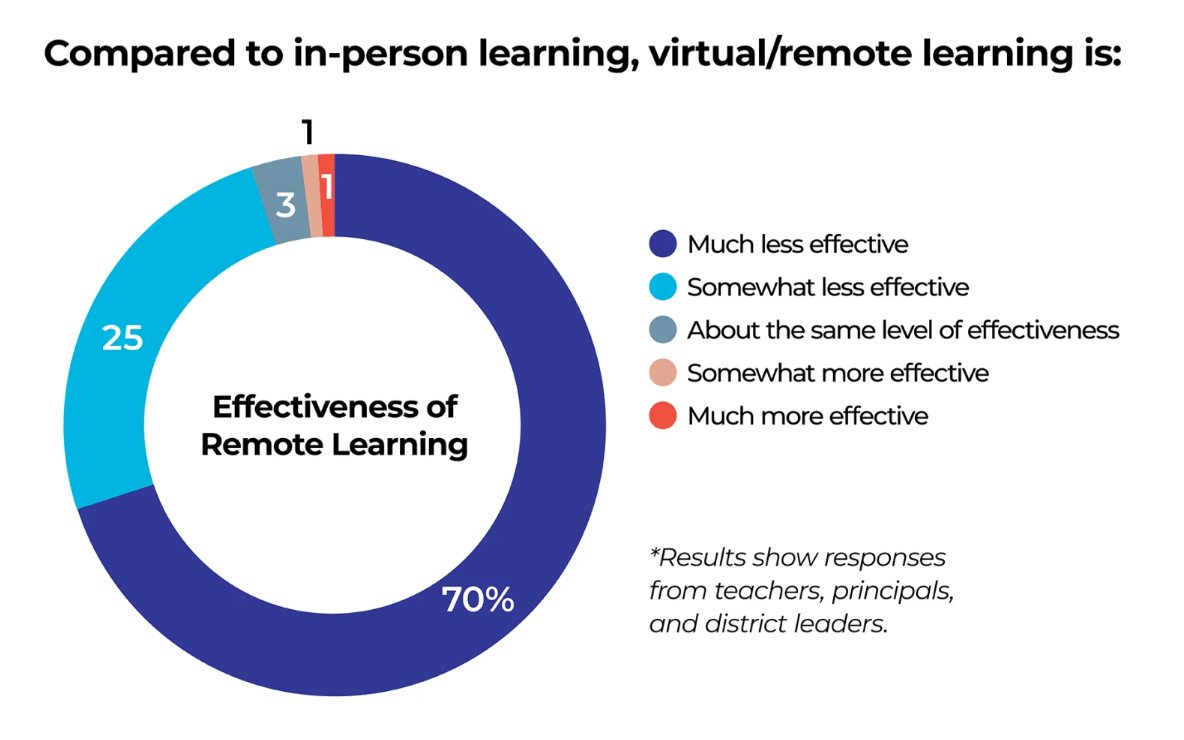
Without a clear sense of how it connects to future success, such as graduation rates or practical skills, the effort loses its value. Teachers and programs must design courses that offer intrinsic rewards, showing students how these lessons matter, whether they're learning a world language or preparing for public schools’ milestones.
How to improve virtual learning experience for attendees?
OK, not everyone will love virtual learning, but can we make it better for them? While you can’t force someone to enjoy the process, you can create an environment that makes it easier and more engaging. Learn how to do it in this section.
Leverage the digital credentials ecosystem
Incorporating digital credentials into virtual learning enhances the student experience by adding value to their efforts. Platforms like Coursera or Credley help integrate credentialing systems, allowing students to earn recognition for their achievements. With this approach, you can bridge traditional education with modern, flexible systems, encouraging learners to stay engaged.
Certifier offers an efficient way to manage these credentials. You can create, manage, and distribute certificates and badges, giving your course added credibility – for example, you can enhance corporate training with digital credentials.
Create and Send Digital Credentials
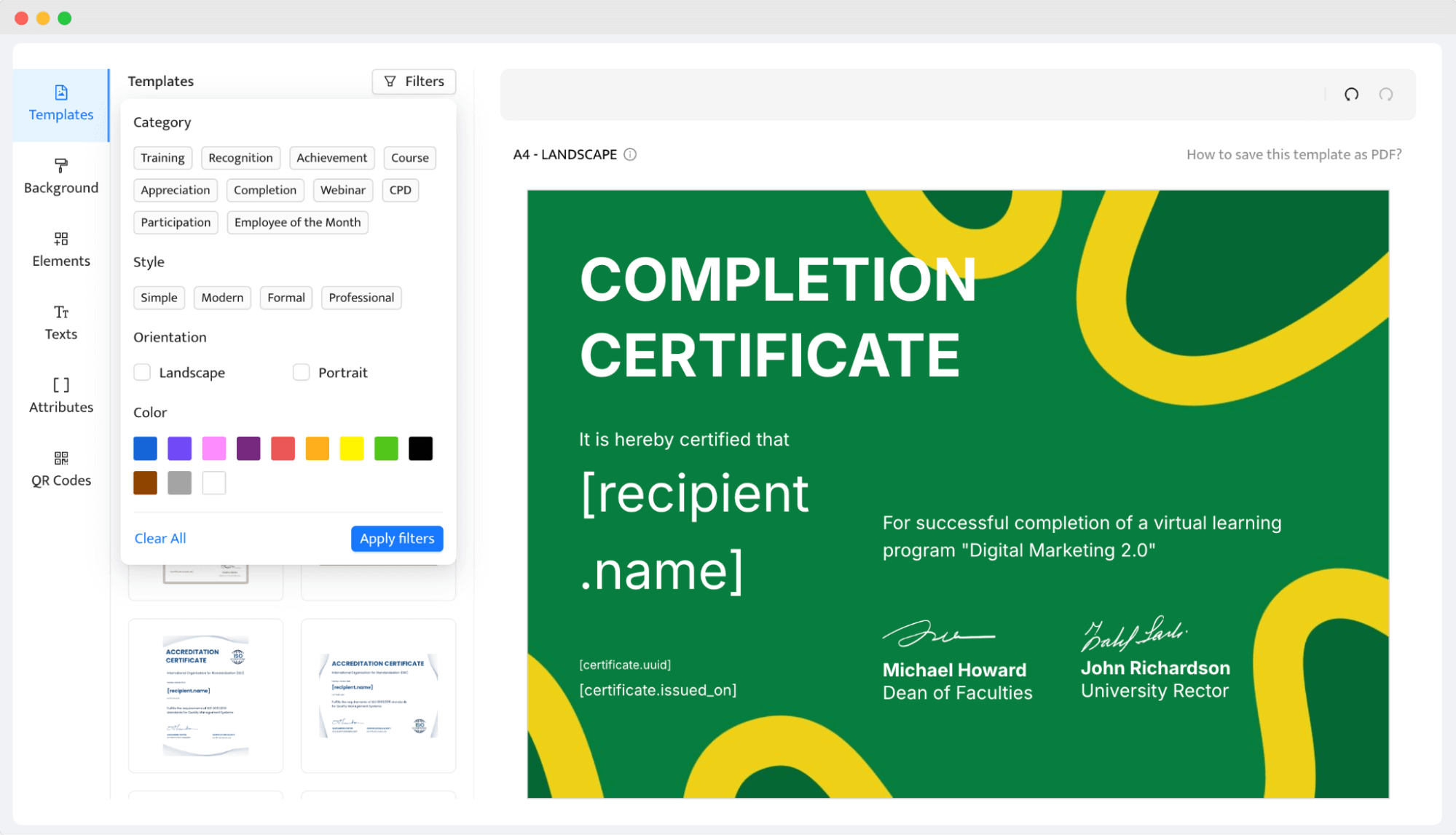
Offer certified courses for recognition
Providing certificates for course completion or achievements boosts learner engagement and satisfaction. For example, offering digital course certificates through platforms ensures students feel their work has practical value. This can help tremendously with motivation but also gives learners something they can showcase professionally.
Certificates also play a huge role for retention, as they are making students more likely to complete their courses. On top of simply issuing certificates, consider creating a certification program to formalize this process. Certificates turn accomplishments into visible achievements and improve the overall learning experience.
Gamify learning with badges and leaderboards
Gamification in virtual learning can significantly enhance engagement and retention. By using leaderboards, custom badges, and certificates as rewards for completing tasks or knowledge-based games, students feel incentivized to continue.
Certifier offers tools to create award certificates, such as free expert-designed certificate templates, which can further boost motivation.
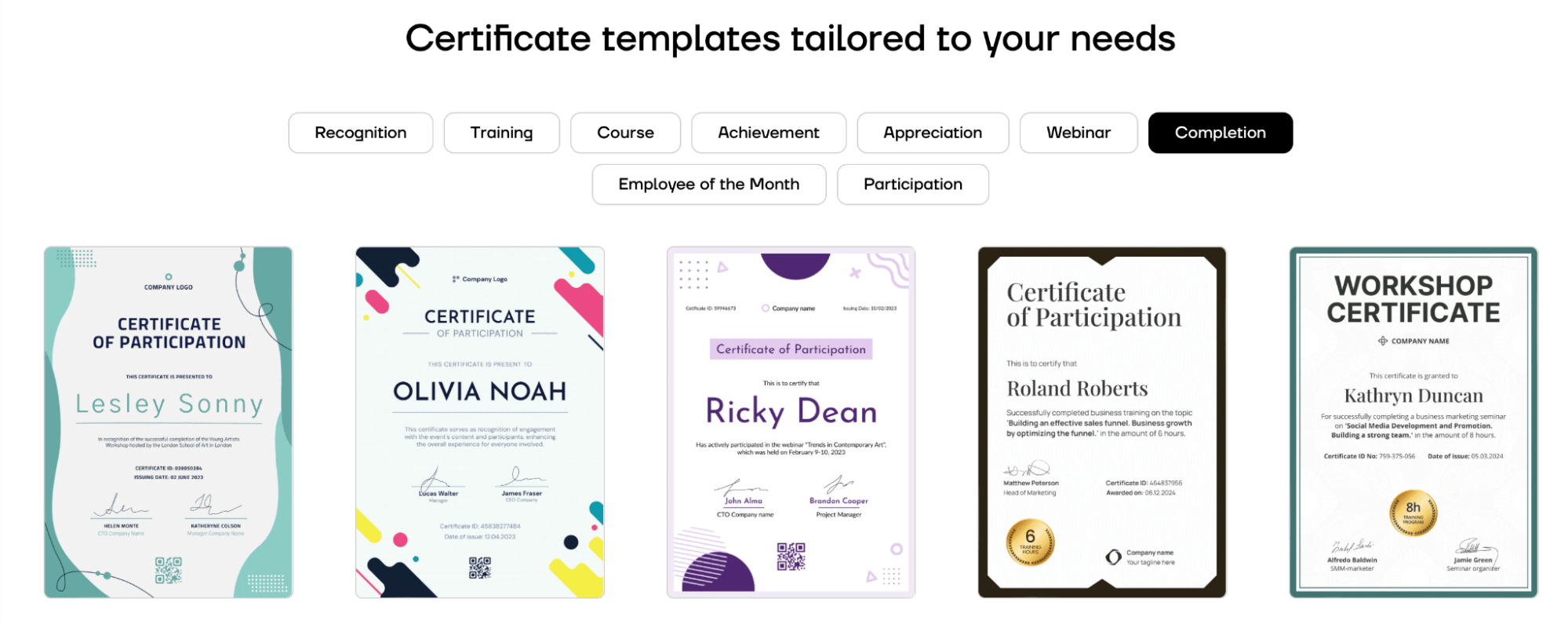
Gamification transforms learning into a more interactive and fun process. This encourages students to strive for recognition, increasing their participation and success rates. Such an approach leads to higher completion rates in online virtual learning environments.
Record your lessons for flexibility
Offering recorded lessons gives students the freedom to learn at their own pace. When lessons are recorded, learners can revisit topics they struggled with, improving retention.
This flexibility will be warmly welcomed by students balancing various commitments – and it ensures no one falls behind. Certifier allows instructors to issue certificates for online students, acknowledging their progress in a self-paced environment.
Recordings also provide a backup for students who may have missed live sessions. Flexibility, combined with recognition, improves the virtual learning experience – and can be exactly what you're missing in your course.
👋 Expert tip: Recording the certification process and tracking details like distribution and engagement can significantly boost your virtual learning program. By keeping an eye on metrics such as certificate opens, shares, and downloads, you can gauge the level of student engagement and satisfaction.
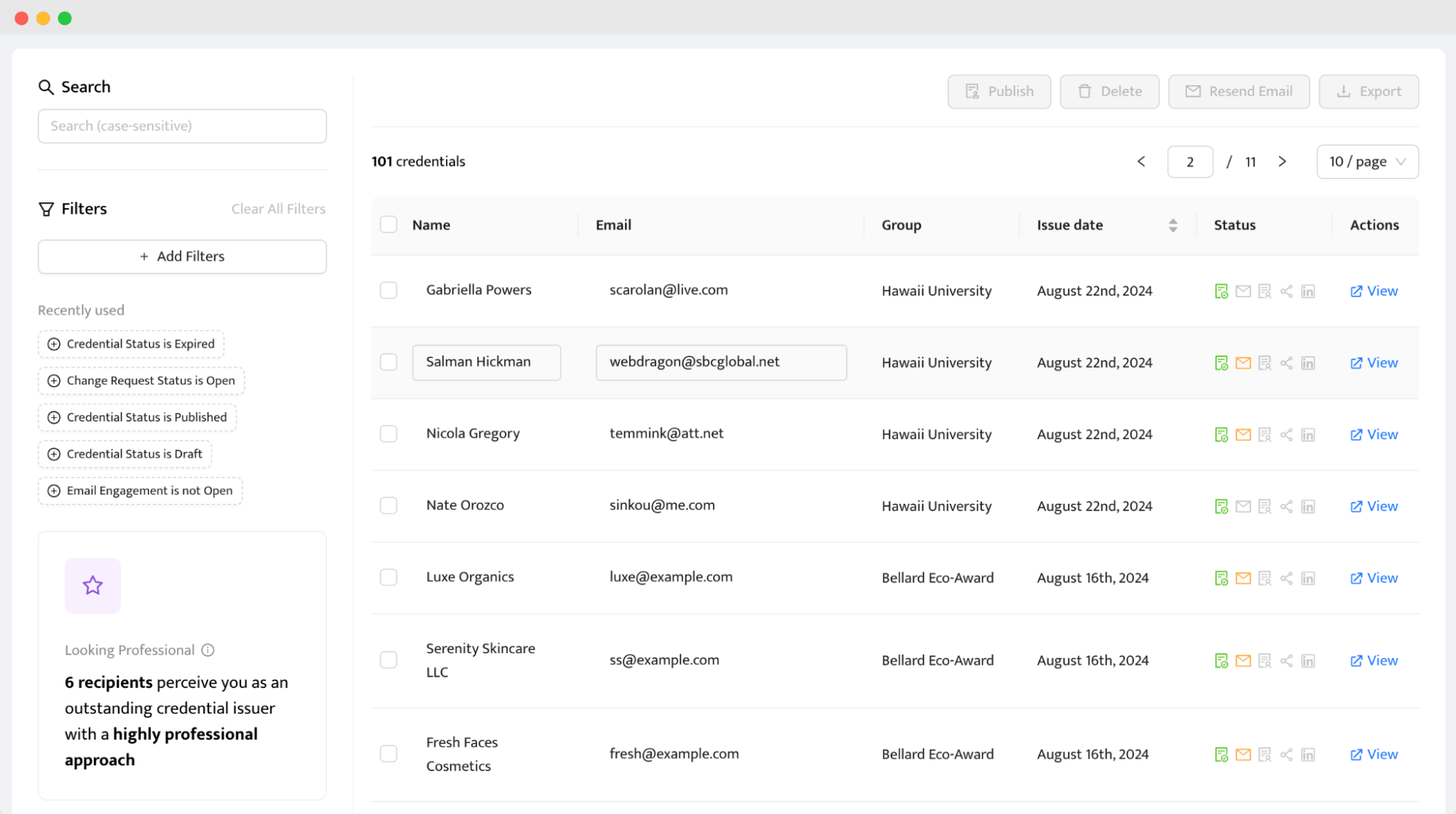
Build personal connections in a virtual classroom
This tip is "easier said than done", but a must-have for continuous success. Creating personal connections between teachers and students can increase engagement and decrease churn rates.
Certifier’s tools make it easy to issue personalized digital course certificates that help students feel recognized at any point during the course or semester. Initiating check-ins, virtual meet-and-greets, or icebreaker activities nurtures belonging.
As a result, students who feel supported and connected are more likely to stay engaged throughout the course. A strong teacher-student relationship leads to higher satisfaction and, eventually, course completion.
Diversify information delivery
Students benefit from having information presented in multiple formats, such as videos, written content, and quizzes. With varied learning materials, educators ensure they cater to different learning preferences. However, don't go from one extreme to another – it's easy to overdo this one.
Offering content through multiple channels keeps the material fresh and exciting, leading to better outcomes.
More effective virtual learning
Virtual learning doesn't have to be challenging. By addressing common hurdles and implementing simple strategies – like offering certificates, gamifying lessons, recording sessions, building personal connections, and diversifying your teaching methods – you can make online education more engaging and enjoyable for your students.
When students feel recognized and rewarded, they're more motivated to participate and succeed.
Ready to boost engagement in your virtual classroom? Try Certifier for free to easily create and distribute personalized digital certificates. Make your virtual courses more effective.
FAQ about virtual learning
Got questions? The following are some of the most common questions about virtual learning.

- B2B SaaS marketing
- Digital Credentials
- Content Strategy
- On-page SEO
- Lead Generation
Head of Marketing
Aksen leads marketing at Certifier, bringing 7+ years of experience with global brands to position digital credentialing as a trusted solution for training providers and educational institutions.


